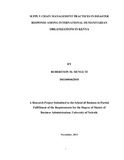| dc.description.abstract | The world has been prone to various disasters, both natural and man-made, which have left devastating effects to the human population. Amongst the many key players in the process response are international non-governmental organizations. Just like the business world, NGOs are required to adopt various management concepts, to help in making informed decisions, and more importantly, to help them undertake their operations in more profound manner. Given this understanding, the objectives of this study are; to determine the relationship between supply chain practices and disaster response among international humanitarian organizations in Kenya, and, to establish the supply chain practices and disaster response among international humanitarian organizations in Kenya.
The study involved the use of primary data that was collection through the use of questionnaires which had both closed and open ended questions. Data collection was by dropping and picking the questionnaires at a later date, to the supply chain/logistics managers or their equivalents, for all the sampled international non-governmental organizations that provide humanitarian support in Kenya. The population of the study was 27 such NGOs. Responses were however received from 19 NGOs, which translated the response rate to stand at 70% of the targeted population. The data that was collected was then analyzed by the use of descriptive statistics. According to the study findings, it was revealed that most of the NGOs used various supply chain practices in their disaster response operations. However, it was notable that the absorption rate of such supply chain practices in these organizations is still low. Many of the organizations had in place practices such as assessment of the needs of the vulnerable population, ordering of services and other materials, management of donations to an optimal level, practices that promote best warehousing, documentation, cataloging, consolidation and recording practices, practices that enhance adequate flow of products enhanced flow of finances and cash, and, inventory management practices. However, the organizations showed a poor response with regard to how they have adopted practices such as supply chain cost management, practices that promote adequate flow of information, investment in technology and supply chain partnership practices. The research study was however subject to certain limitations such as, the fact that response rate for the questionnaires was relatively low, the study was based only on a sample of international NGOs, which limited information from other set of NGOs, the size of the sample was relatively small, which could have affected the accuracy of the findings, and, the fact that the data collection was done through sampling which could have meant significant impact on the kind of data so collected. Given these shortcomings, there is therefore need for a future research study which may bridge the gap in these limitations. | en |

